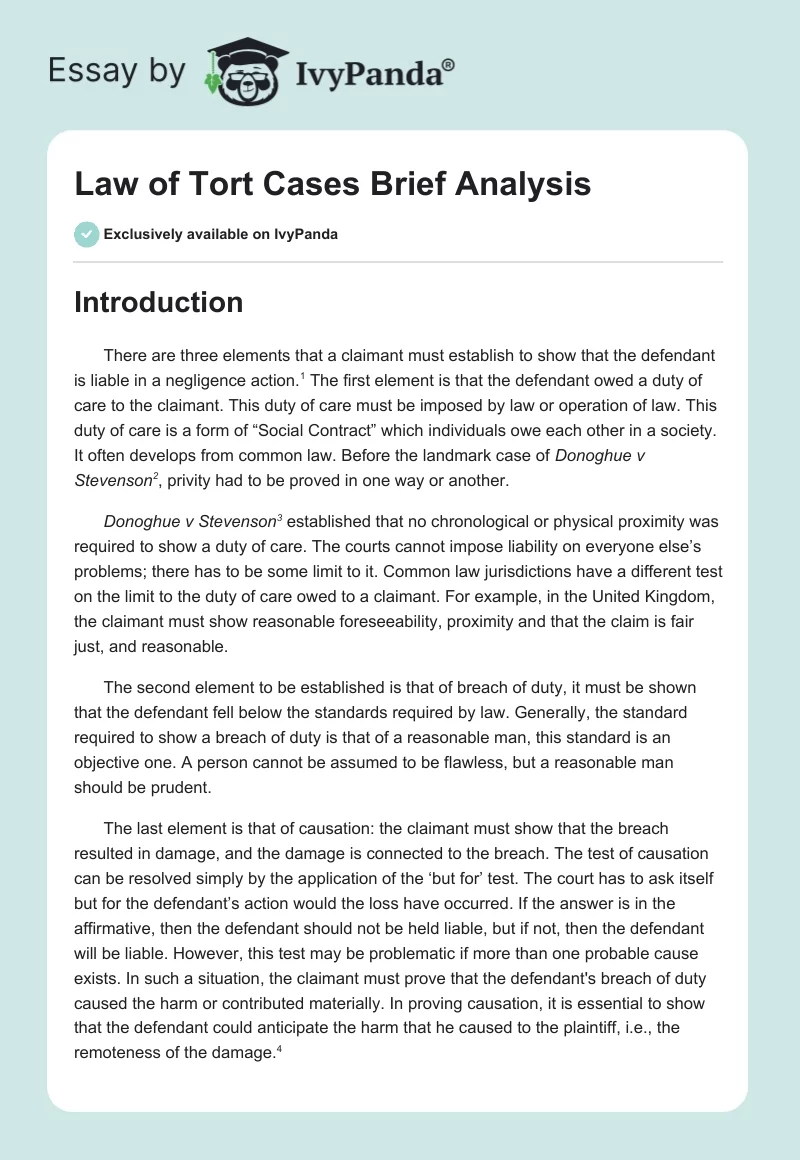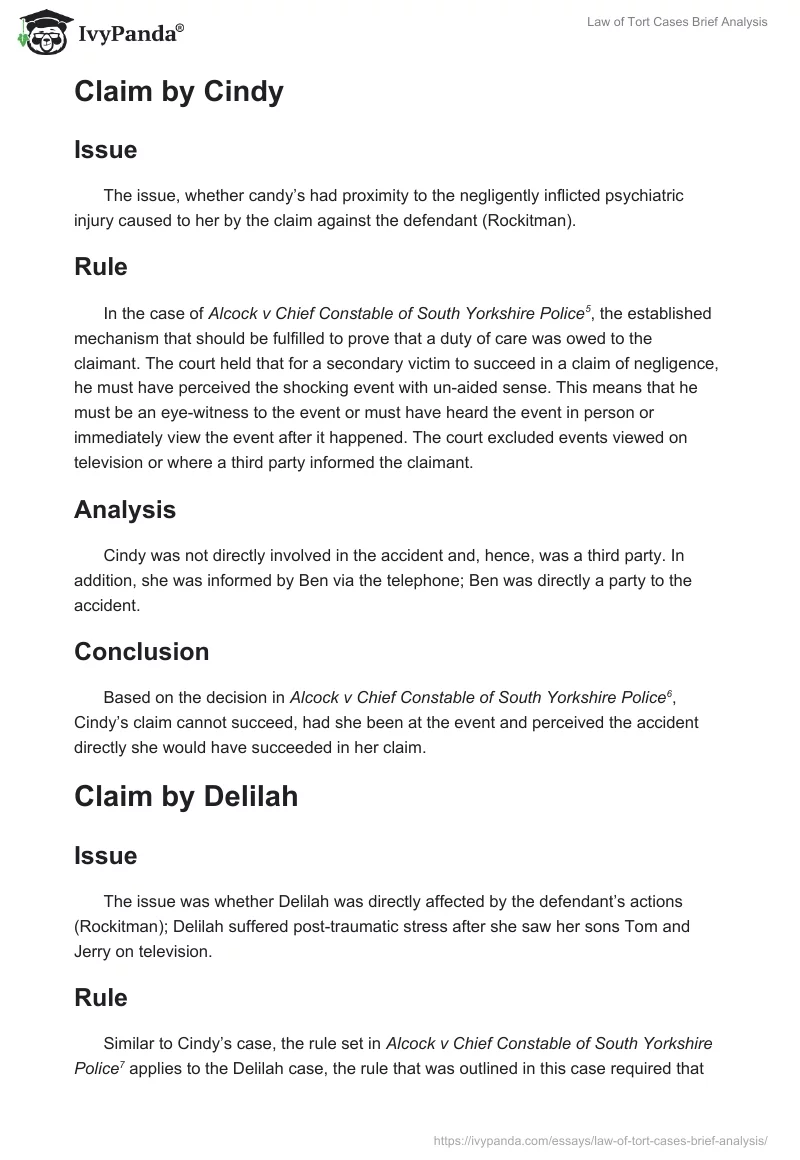Introduction
There are three elements that a claimant must establish to show that the defendant is liable in a negligence action. The first element is that the defendant owed a duty of care to the claimant. This duty of care must be imposed by law or operation of law. This duty of care is a form of “Social Contract” which individuals owe each other in a society. It often develops from common law. Before the landmark case of Donoghue v Stevenson, privity had to be proved in one way or another.
Donoghue v Stevenson established that no chronological or physical proximity was required to show a duty of care. The courts cannot impose liability on everyone else’s problems; there has to be some limit to it. Common law jurisdictions have a different test on the limit to the duty of care owed to a claimant. For example, in the United Kingdom, the claimant must show reasonable foreseeability, proximity and that the claim is fair just, and reasonable.
The second element to be established is that of breach of duty, it must be shown that the defendant fell below the standards required by law. Generally, the standard required to show a breach of duty is that of a reasonable man, this standard is an objective one. A person cannot be assumed to be flawless, but a reasonable man should be prudent.
The last element is that of causation: the claimant must show that the breach resulted in damage, and the damage is connected to the breach. The test of causation can be resolved simply by the application of the ‘but for’ test. The court has to ask itself but for the defendant’s action would the loss have occurred. If the answer is in the affirmative, then the defendant should not be held liable, but if not, then the defendant will be liable.
However, this test may be problematic if more than one probable cause exists. In such a situation, the claimant must prove that the defendant’s breach of duty caused the harm or contributed materially. In proving causation, it is essential to show that the defendant could anticipate the harm that he caused to the plaintiff, i.e., the remoteness of the damage.
Claim by Cindy
Issue
The issue, whether candy’s had proximity to the negligently inflicted psychiatric injury caused to her by the claim against the defendant (Rockitman).
Rule
In the case of Alcock v Chief Constable of South Yorkshire Police, the established mechanism that should be fulfilled to prove that a duty of care was owed to the claimant. The court held that for a secondary victim to succeed in a claim of negligence, he must have perceived the shocking event with un-aided sense. This means that he must be an eye-witness to the event or must have heard the event in person or immediately view the event after it happened. The court excluded events viewed on television or where a third party informed the claimant.
Analysis
Cindy was not directly involved in the accident and, hence, was a third party. In addition, she was informed by Ben via the telephone; Ben was directly a party to the accident.
Conclusion
Based on the decision in Alcock v Chief Constable of South Yorkshire Police, Cindy’s claim cannot succeed, had she been at the event and perceived the accident directly she would have succeeded in her claim.
Claim by Delilah
Issue
The issue was whether Delilah was directly affected by the defendant’s actions (Rockitman); Delilah suffered post-traumatic stress after she saw her sons Tom and Jerry on television.
Rule
Similar to Cindy’s case, the rule set in Alcock v Chief Constable of South Yorkshire Police applies to the Delilah case, the rule that was outlined in this case required that the injured person must be physically there to perceive the event. However, in the case of Mclaughn v O’Brien Lord Wilberforce delivered a speech in which he argued that in addition to the proximity, with the accident, there has to be a close relationship between the plaintiff and the victims of the accident.
Analysis
Delilah being at home and watching the event on the television is not a proxy to the event happening of the event. She chose to send her husband to check on her sons. By sending her husband, she does not satisfy the first test that McLoughlin v O’Brien, that of proximity. However, she is closely related to Tom and Jerry as she is their mother.
Conclusion
The fact that she is closely related to the victim of the accident partly fulfills the test established in McLoughlin v O’Brien. However, her being in proximity negates her claim.
Claim by Samson
Issue
Samson was present at the tragic event immediately after it happened, he was sent by his wife to check on their sons; he developed pathological grief disorder after the event. The issue is whether Samson was a proxy to the event.
Rule
The same case of Alcock v Chief Constable of South Yorkshire Police applies to this case. The case established the rule that a secondary victim must perceive a shocking event. The case also ruled that the shock suffered must be sudden in contrast to gradual. The other rule is that of sufficient proximity.’
This rule requires that the primary victim should be related to the secondary victim, and there exists to love and affection between them. It is presumed that love and affection exist between parents and their children, a spouse and his fiancée or siblings. The claimant must prove the existence of love and affection. The person in the claimant’s position should be in a formal fortitude position to have foreseen the consequences of his actions.
Analysis
Samson being a secondary victim has proximity to the event having perceived the event immediately after it happened. In addition, the shock suffered by Samson was immediate and, hence, fell within the test set Alcock v Chief Constable of South Yorkshire Police. Samson has sufficient proximity as he is the parent to the primary victims, i.e. Tom and Jerry. Finally, for Samson to succeed, it must be proven that he was in a position of formal fortitude for the defendant to have foreseen the psychiatric injury.
Conclusion
Samson being the parent top, Tom and Jerry have sufficient proximity. The shock was also sudden and immediate. Therefore, Samson would succeed in a negligent claim against Rockitman.
Claim by Kan
Issue
Kan an off-duty police officer witnessed the occurrence of the crash. He develops depression after he fainted on thinking he saw the body of his brother. The issue is whether Kan can succeed in a claim of negligence against Rockitman and his insurers.
Rule
The case of Bourhill v Young established the jurisprudence on the circumstances to which a bystander can recover damages, in a negligent case, whereby, physical harm did not occur. The court held that a woman who suffered psychiatric harm was not deemed to be a foreseeable victim after she walked into a motorcycle accident scene.
This can be contrasted with the case of Page v Smith concerned foreseeability of psychotic damage. It creates a distinction in the English common law of negligence between primary victims and secondary victims. In this case, Mr. Page, the plaintiff was physically unhurt after a minor road accident. He suffered from myalgic encephalomyelitis a recurring condition which he had for 20 years but had remised. The court held that Mr. Page was a primary victim because he has been directly involved in the accident, contrary to the previous cases brought before the House of Lords.
Similarly, the case McFarlane v EE Caledonia Limited the court held that a claim by the plaintiff as he was possible as he was not a man of ordinary fortitude, and thus his claim was not reasonably foreseeable.
The case of Chadwick v British Railway Board established that primary victims who helped in the accident directly can recover damages against the defendants as the defendant could reasonably foresee the injury suffered by Kan, i.e. rescuers. The court, in that case, held that a rescuer cannot be deprived of his remedy even though the shock suffered by him is not the same suffered by the accident victim.
The case of White v Chief Constable of South Yorkshire Police brings a slightly different rule, had Kan been on duty he would not have succeeded as he would have been a professional rescuer and, thus, not in a better position than a bystander.
Analysis
Kan was not directly involved in the accident and was not a primary victim according to Page v Smith, however, he participated directly as a rescue.
Conclusion
Kan would succeed in a negligence claim against the defendant for he was a direct participant in the rescuing activity and that the defendant reasonably foresaw the consequences of his actions.
Second Scenario
In the second scenario, the issue was whether Tom and Jerry consented to the action either impliedly or expressly.
Rule
In English tort law, a defendant can be fully exonerated from a claim if he proves two elements. First that the claimant was aware of the risk in which he was getting into and second if the claimant consented to waive the claim either implied or expressly however the consent must be voluntary. These are captured by the maxim of volenti non-fit injuria.
According to the case of Morris v Murray where the plaintiff flew with the pilot knowing top well that they were both drunk, shortly after taking off they crashed. The plaintiff brought an action against the pilot arguing that there was no voluntary assumption of risk the court held that the plaintiff consented to the action voluntarily and would, therefore, not succeed.
Analysis
In analyzing Tom and Jerry’s action concerning Rockitman, the circumstances are similar to those of Morris v Murray as they had been drinking together and encouraging him to loop his famous maneuver. It can be taken as expressly consenting to the actions of the defendant. Williams argues in the modern law review that whether acceptance of the risk preceded or followed the risk was immaterial but what was material – the level of intoxication of the passengers.
Conclusion
Tom and Jerry cannot succeed in a claim of negligence against the defendant because by voluntarily assuming the risk, they fully exonerated him.
References
Andoh, B. Illegality as a defence to negligence in English law. London, Mountbatten Journal of Legal Studies, 2007.
Barker M., Negligence: Causation and Remoteness of Damages, (2004) University of London External Programme.
Bourhill v Young, e-law resources. Web.
Causation in Tort Law, e-law resources. Web.
Donoghue v Stevenson, British and Irish Legal Information Institute. Web.
McFarlane v EE Caledonia, British and Irish Legal Information Institute. Web.
Tufal, A. The Tort of Negligence. Web.
Williams K. (1991) Defenses for Drunken Drivers: Public Policy on the Roads and in the Air, London, Modern Law Review.


